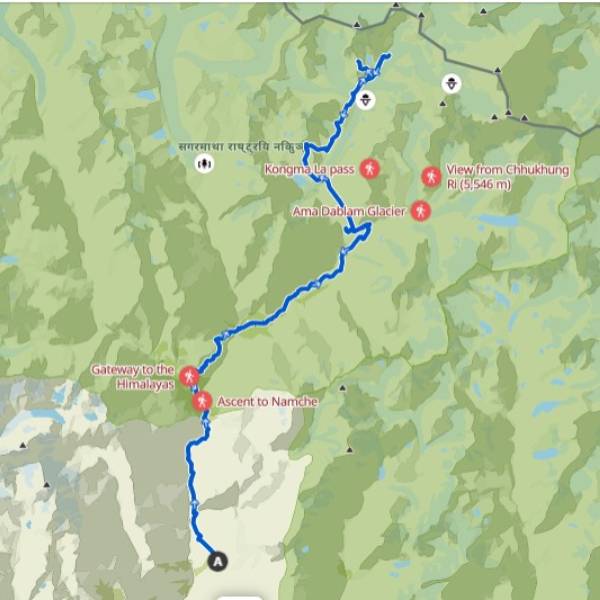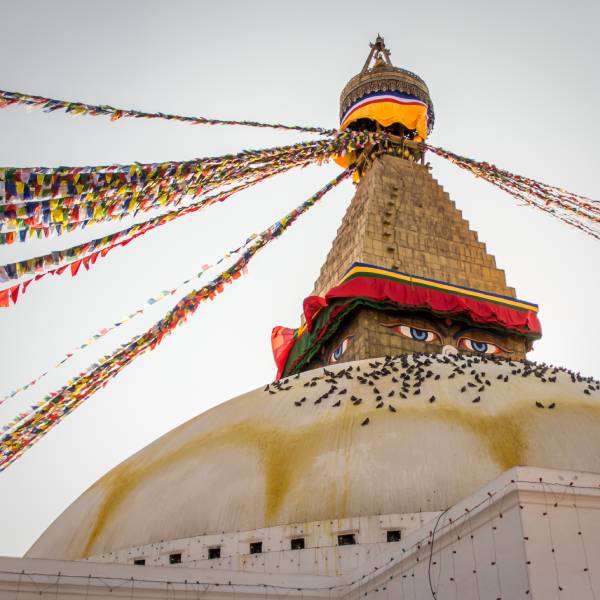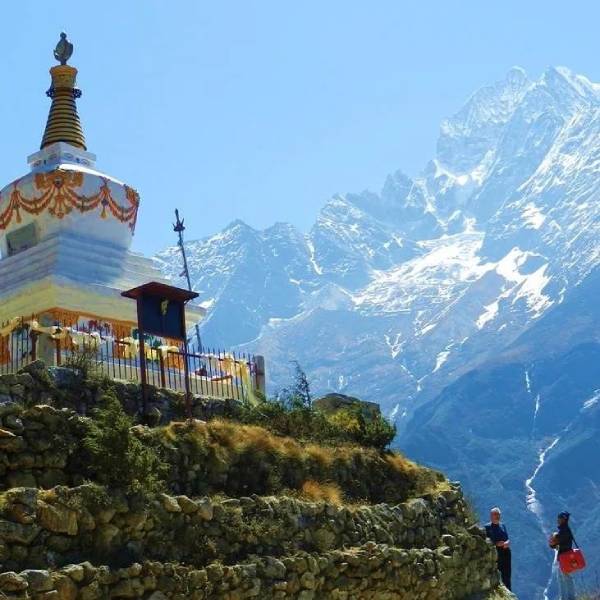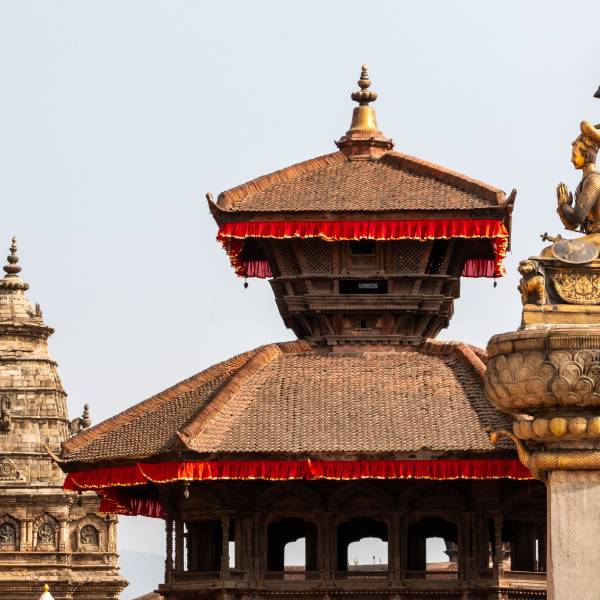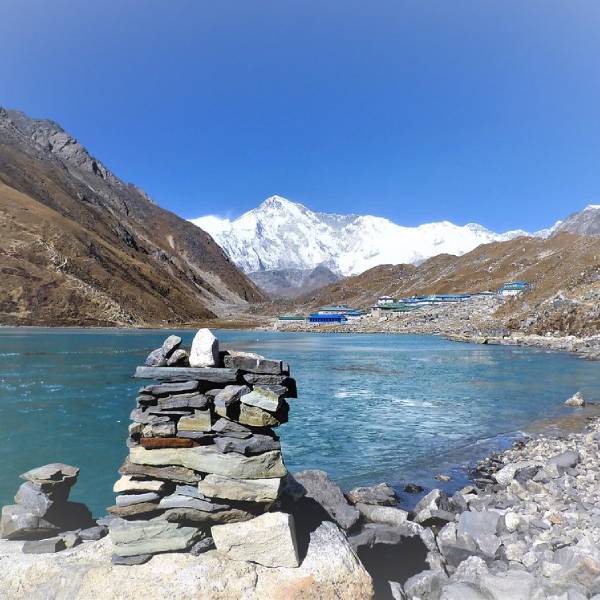Everest Base Camp Trek
Tours Details
- Home
- Nepal Luxury Travel
- Everest Base Camp Trek
Everest Base Camp Trek
Everest Base Camp, situated at an altitude of 5,364 meters (17,598 feet), serves as the starting point for climbers attempting to summit Mount Everest. The trek to Base Camp is renowned for its breathtaking panoramic views of some of the highest Himalayan peaks, including Everest itself, Lhotse, Nuptse, and the iconic Ama Dablam. Along the route, trekkers pass through charming Sherpa villages known for their warm hospitality and rich cultural heritage. The trail also winds through lush forests and visits colorful Buddhist monasteries, providing insight into the spiritual life of the region. One of the key stops is Namche Bazaar, the vibrant trading hub of the Khumbu area, where trekkers can experience local markets and traditional cuisine. This journey offers a unique blend of natural beauty, cultural immersion, and physical challenge, making it an unforgettable adventure for those seeking to explore Nepal’s majestic Himalayan landscape.
Short Itinerary
| Title | Accommodation | Meals |
| Day 1: Arrive in Kathmandu | Hotel | |
| Day 2: Briefing and Full-day Sightseeing at Kathmandu | B | Hotel |
| Day 3: Fly to Lukla/ trek to Phakding (2652m/ 8701 ft)) approx. 03hrs. trek | B | Simple Lodge |
| Day 4: Trek to Namche Bazaar (3,440m/ 11286 ft) 06-07 hours trek | B | Simple Lodge |
| Day 5: Rest day at Namche Bazaar | B | Simple Lodge |
| Day 6: Trek to Tengboche (3,867m/ 12687 ft) 05 hours trek | B | Simple Lodge |
| Day 7: Trek to Dingboche (4,358m/ 14298 ft) 05-06 hours trek | B | Simple Lodge |
| Day 08: Acclimatization Day at Dingboche | B | Simple Lodge |
| Day 09: Trek to Lobuche (4,928m/ 16168 ft) 06 hours trek | B | Simple Lodge |
| Day 10: Trek to EBC and back to Gorakshep (5190m/ 18193) 06 -07 hours trek | B | Simple Lodge |
| Day 11: Trek to Kalapathar and back to Pheriche (4230m/ 13878 ft) 08 hours trek | B | Simple Lodge |
| Day 12: Trek to Khumung (3790 m/ 12434 ft), 6 hours trek | B | Simple Lodge |
| Day 13: Trek to Phakding (2610m/8701ft), 7 hours trek | B | Simple Lodge |
| Day 14: Trek to Lukla (2860 m/ 9383 ft), 5 hours trek | B | Simple Lodge |
| Day 15: Fly to Kathmandu from Lukla | B | Hotel |
| Day 16: Full-day Sightseeing at Kathmandu | B | Hotel |
| Day 17: Final departure | B |
Tour Program
Expand AllUpon arriving at Tribhuvan International Airport, you will be warmly greeted by our representative, who will assist you with your luggage and guide you through the arrival process. From there, you’ll be transferred to your pre-booked hotel, ensuring a smooth and comfortable start to your journey in Nepal.
Hotel
Hotel
B
Your Himalayan adventure begins with an exhilarating morning flight from Kathmandu to Lukla (2,860m), where the plane's dramatic landing on the mountainside runway sets the tone for the journey ahead. After meeting your Sherpa team, the trek descends gently through fragrant pine forests alongside the Dudh Koshi River, its milky waters rushing over smooth boulders. The trail weaves past mani walls carved with sacred Buddhist mantras and through traditional villages where yaks graze in terraced fields. A highlight comes as you cross the Tarhe Khola suspension bridge, with Kusum Kanguru's snow-clad peak (6,369m) dominating the northern skyline. By mid-afternoon, you'll arrive in Phakding (2,610m), where cozy teahouses await beside the river's soothing murmur, the perfect introduction to Everest region trekking.
Simple Lodge
B
The trail unfolds along the roaring Dudh Koshi, crossing five suspension bridges draped with prayer flags that flutter in the Himalayan wind. After passing Benkar’s terraced fields with Thamserku (6,608m) looming above, we enter Sagarmatha National Park at Monjo, where Sherpa women demonstrate traditional tsampa flour production using water-powered mills.
The real challenge begins after Jorsalle, a steep 600m ascent to Namche (3,440m) along switchbacks offering "Everest teaser" views. Kwangde’s razor-edged peaks dominate the eastern skyline while occasional clearings reveal Everest’s distant summit peeking between Nuptse and Lhotse. As we round the final bend, Namche’s colorful houses appear like a mirage, stacked dramatically in their natural amphitheater, a thriving Himalayan hub where yak caravans share narrow alleys with cozy bakeries and gear shops.
Simple Lodge
B
Start your morning with a gentle climb to Sagarmatha National Park headquarters (3,700m), where panoramic views unfold across the Khumbu Valley - Ama Dablam's elegant pyramid, Everest's distant summit, and Thamserku's icy flanks dominate the skyline. The nearby museum showcases the region’s rich heritage through engaging exhibits, featuring historic climbing equipment from early Everest expeditions, traditional Sherpa cultural artifacts, and informative displays about local wildlife, including snow leopards and red pandas. After lunch at a café overlooking Namche's amphitheater of colorful rooftops, the afternoon offers leisurely exploration. Browse Tibetan handicrafts, sample fresh-baked pastries at world-famous bakeries, or simply relax with a book in the sunshine. As evening falls, join locals at the stone-paved plaza to hear tales of legendary Sherpa mountaineers while sipping butter tea - the perfect active rest day blending culture, history, and Himalayan splendor.
Simple Lodge
B
Approx walking time: 5hrs.
The trail unveils Everest's mighty neighbors as you descend through rhododendron forests alive with wildlife, spot Nepal's colorful Danphe pheasants and watchful musk deer. After crossing the Imjaste River at Phungitenga, pause at a unique water-powered prayer wheel spinning ceaselessly in the mountain stream. The path then climbs through fragrant juniper groves to a sacred mani wall adorned with offerings, where Thamserku's icy face looms overhead.
Arriving at Tengboche (3,867m), the Himalayas unfold in full glory, Ama Dablam's elegant pyramid dominates the foreground while Everest's summit pierces the sky behind Nuptse's massive wall. The monastery's evening puja ceremony fills the valley with chanting and horn blasts, as golden light bathes the world's highest peaks in alpenglow.
Simple Lodge
B
Trekking time: 5-6hrs.
The trail moves through a fragrant mix of birch and rhododendron, emerging at Debouche (3,650m), where Ama Dablam’s icy flanks dominate the skyline. Passing a winding mani wall, the route crosses a small bridge before splitting. The upper path leads to Pangboche s ancient monastery, once home to a mysterious Yeti relic, while the lower trail continues toward Dingboche. A short detour to the village rewards trekkers with dramatic Himalayan vistas before rejoining the main path beneath Kantenga Peak’s rugged northern face.
The journey then weaves eastward, skirting Ama Dablam’s sheer walls before climbing to a hilltop stupa. The Imja Valley stretches ahead, with Island Peak shimmering like a jewel on the horizon. Stone-walled fields mark the approach to Dingboche, where barley sways in the wind, offering a tranquil pause in the heart of the high mountains.
Simple Lodge
B
Start your morning with a visit to Dingboche's storied monastery, where legends of the mythical Yeti still linger among ancient Buddhist artifacts. Then embark on a gentle hike up the Imja Valley, following the turquoise glacial river toward Island Peak Base Camp. This strategic acclimatization walk offers unparalleled views of Ama Dablam's dramatic north face and the towering Lhotse-Nuptse wall, their icy slopes glowing in the morning light.
Return to Dingboche by midday for a well-earned rest. Spend your afternoon soaking in mountain vistas from the village's sunny terraces, washing trail-dusted clothes, or sipping hot lemon ginger tea at a cozy teahouse. This peaceful interlude prepares both body and spirit for the higher altitudes to come.
Simple Lodge
B
Approx trekking time: 06 hrs.
The morning trail ascends gradually past a ridge dotted with chortens, unveiling Pheriche village cradled in the valley beneath. As you progress, the Himalayan giants dominate the skyline, Tawache's sharp ridges, Ama Dablam's curling glaciers, and Nuptse's massive wall glowing in the sunlight. After joining the main trail at Dugla (4,595m), pause for tea beside the Khumbu Glacier's milky streams, where the crunch of ice underfoot signals your approach to Everest's domain.
The final push to Lobuche (4,940m) ascends past memorials to fallen climbers, their prayer flags snapping in the thin air. Cresting the moraine, Pumori's pyramid comes into view as you descend into the wind-sheltered lodges of Lobuche, your high-altitude haven for the night, where steaming mugs of ginger tea await to ward off the evening chill.
Simple Lodge
B
The glacier groans beneath us as dawn fingers pry apart night's grip, revealing our path through this kingdom of ice. The trail weaves between ice-scoured boulders and turquoise meltwater pools, where reflections of Pumori's imposing face shimmer like liquid mercury. By mid-morning, the windswept outpost of Gorak Shep (5,164m) emerges, a ghostly remnant of the original 1953 Everest expeditions, its dust-blown lodges dwarfed by Kalapatthar's dark pyramid.
Standing at this hallowed ground, the mountain's presence is palpable: the distant roar of avalanches on Nuptse's flanks, the rustle of expedition prayer flags, the crisp thin air carrying whispers of climbing legends. As daylight fades, we'll watch the Western Cwm glow crimson, a preview of tomorrow's journey to Everest Base Camp itself.
Simple Lodge
B
We depart Gorak Shep before dawn, headlamps cutting through the freezing darkness (-15°C) as we ascend Kalapatthar's rocky spine. The final 400m push demands every ounce of determination, but reaching the summit (5,545m) at sunrise rewards us with Everest's crowning glory, the first golden light igniting the world's highest peak while the Khumbu Glacier snakes silver below. This 360° theater of giants showcases Nuptse's razor ridge, Pumori's perfect pyramid, and the treacherous Lho-La pass where Mallory vanished.
Descending past memorial chortens, we retreat to Pheriche's (4,371m) oxygen-rich valley, where the Himalayan Rescue Association clinic stands ready for altitude checks. As yak bells lull us to sleep, the imprinted image of that sunrise remains, a burning memory no photograph could capture.
Simple Lodge
B
Our descent from the high Himalayas begins with a rejuvenating walk down the Imja Khola valley, where the air grows thicker with each step. Passing through Pangboche, we visit its ancient monastery, home to mystical relics and panoramic views of Ama Dablam's soaring ridges. The trail then winds through fragrant rhododendron forests to Khumjung (3,867m), Hillary's "green valley," where terraced fields of barley and potato surround traditional stone houses.
Arriving by mid-afternoon, we'll settle into a cozy lodge with its sunny garden, perfect for shedding layers and savoring the return to oxygen-rich air. Don't miss the chance to try Khumjung’s famous apple brandy, distilled from orchards planted by the Himalayan Trust, as the sunset paints Everest's distant summit pink.
Simple Lodge
B
The last day of trekking opens with a serene ridge walk high above the Dudh Koshi, revealing breathtaking aerial views of Namche’s terraced amphitheater and Ama Dablam’s distant peak. The mountains release us gently, through cathedral pines alive with warbling thrushes, past startled pheasants exploding like sapphire fireworks from the brush. In Namche (3,440m), we pause for a final coffee at its cozy bakeries, savoring the last moments of mountain hospitality. Then, we retrace our journey downward, crossing familiar swaying suspension bridges, the rushing river below growing louder as we lose elevation. By the time we reach Phakding (2,610m), the air is warmer, the vegetation lush and vibrant, a comforting return to the valley, as if the mountains are gently releasing us back to the world below.
Simple Lodge
B
Our last trekking day follows the Dudh Koshi's turquoise waters through vibrant rhododendron forests and past traditional villages. The trail blends gentle ascents with flat riverbank stretches, crossing familiar suspension bridges adorned with prayer flags that now feel like old friends. In Jorsalle, we'll pause at the national park checkpoint, where our permits get their final stamps, before the final climb through Chaurikharka's terraced fields to Lukla (2,860m).
Arriving by midday, we'll celebrate at a local lodge with Everest beers and nostalgic storytelling. The afternoon offers time to explore Lukla’s lively streets, visit the mountaineering memorials, or relax, our boots finally still after days of Himalayan wandering.
Simple Lodge
B
The thunder of propellers jolts us awake at dawn, and Lukla’s infamous weather demands an early departure. As our Twin Otter leaps off the tilted runway, Everest's silhouette waves farewell through morning clouds. The 35-minute flight treats us to a final aerial show: terraced hillsides giving way to Kathmandu's urban sprawl.
By mid-morning, we're sipping fresh juice at our hotel, where hot showers and cotton sheets feel like luxuries. The afternoon unfolds slowly, sorting photos that barely capture the mountains' grandeur, repacking souvenirs (a singing bowl, prayer flags), and perhaps a massage for trail-weary muscles. As evening falls over the bustling city, we'll gather for a farewell dinner, our conversation still drifting back to icy passes and Sherpa hospitality. The Himalayas may fade from view, but their imprint on us remains as permanent as the snow on Everest's crown.
Hotel
B
Today’s itinerary showcases Kathmandu’s spiritual and historical gems, the revered Pashupatinath, the serene Boudhanath, and Bhaktapur’s UNESCO-listed Durbar Square, offering a glimpse into Nepal’s rich heritage.
Pashupatinath - Where Life and Eternity Meet: The Bagmati's holy waters mirror centuries of prayers as Pashupatinath's golden spires hum with devotion to Shiva, where smoke from pyres carries souls and saffron-clad priests chant ancient mantras. The air carries both the scent of incense and the solemnity of cremation rituals, offering a raw glimpse into Nepal's cycle of life and death. Priests chant, saffron-robed sadhus meditate, and the faithful gather in this sacred crossroads of mortality and faith.
Boudhanath- A Mandala of Peace: The great white stupa of Boudhanath rises like a celestial mountain, its golden spire piercing the sky. Pilgrims circle clockwise, spinning prayer wheels as fluttering mantras dissolve into the wind. In surrounding monasteries, the rhythmic drone of monks chanting blends with the clatter of teacups, creating a living tapestry of Tibetan Buddhism.
Bhaktapur - A Stone Chronicle of Kings: Time crystallizes in Bhaktapur's Durbar Square, where the 55-Window Palace's carved deities still watch over the city. The Nyatapola Temple's five-tiered majesty - each level guarded by stone strongmen - has withstood centuries, while the Vatsala Temple's legendary bell keeps barking at the heels of history. Every brick here whispers Newari glory.
Hotel
B
Your final Kathmandu morning includes breakfast and a smooth airport transfer. As the prayer wheels spin for your safe journey, we plant the seed for your next Nepal adventure.
B
Tour Includes
- Meet at the airport with our representative and transfer to the hotel as booked.
- 04 nights’ accommodation at Hotel – Kathmandu, Single Room on BB plan.
- 12-night/13-day stay in simple lodges during the EBC trek.
- Trek is accompanied by a local English-speaking sirdar and porter.
- All surface transfers as per the itinerary by private a/c vehicle equipped with bottled water & wet tissues.
- In Kathmandu Sightseeing, an English-speaking guide is included.
- Everest Conservation fees, VDC Tax, and TIMS card.
Tour Excludes
- Nepalese Visa Fee.
- Domestic and International airfare and taxes. Quoted Separately.
- Meals that are not mentioned in the itinerary.
- Refreshments, tips, bottled drinks, and bar bills.
- Insurance and rescue of any form.
- Cost arising out of flight cancellation/road blockades/landslides and reasons beyond our control.
- Expenses of a personal nature and any other expenses not mentioned in the above cost.
- Gratuities to trek staff, trek leader, city guide, and driver.
- Excess baggage charges
- Personal insurance policy - suggested comprehensive travel insurance covering tour and flight cancellations, loss of valuables, thefts, illness, accidents, and hospitalization.
- Supplement food supply during the trek. Freshly ground coffee & Darjeeling Tea were carried.
FAQ
Expand AllThe best time for the Everest Base Camp trek is pre-monsoon (March to May) and post-monsoon (September to November). During these months, the weather is clear, and the temperature is more favorable for trekking.
The EBC trek is considered moderate to challenging. The trek involves long days of walking, and the altitude can cause discomfort due to the high elevations. Proper acclimatization is essential to avoid altitude sickness.
You should be in good physical condition, as the trek involves walking for several hours each day, often on steep terrain. Regular cardio exercises like hiking, running, or cycling will help you prepare for the trek.
The highest point of the trek is Kala Patthar at 5,545 meters (18,192 feet), with the Everest Base Camp itself located at 5,364 meters (17,598 feet).
The trek lasts around 12 to 14 days, depending on acclimatization and the pace of the group. The total trekking time is usually around 6–8 hours per day.
While prior trekking experience is helpful, novice trekkers can also attempt the trek with sufficient preparation and stamina. However, you should be prepared for cold weather, long days of walking, and high-altitude trekking.
- Warm clothing (layering system)
- Good trekking boots
- Sleeping bag suitable for cold temperatures
- Sunscreen, sunglasses, and hat
- Water bottle with purification system
- First aid kit and personal medications
There are basic medical facilities in Namche Bazaar and other major towns along the way. However, for serious conditions, evacuation may be required, and Helicopter rescue services are available for emergencies.
The itinerary is designed with enough acclimatization days (like in Namche Bazaar and Dingboche) to help reduce the risk of altitude sickness. It’s important to drink plenty of water, avoid overexertion, and inform the guide if you experience symptoms such as headaches, dizziness, or nausea.
Accommodation is typically in simple lodges/tea houses along the route. They provide basic amenities like beds, blankets, and shared bathrooms. Hot water, electricity, and Wi-Fi may be available in higher settlements, though they may incur extra charges.
Yes, the lodges along the trekking route provide local food like dal bhat (lentil soup with rice), momo (dumplings), noodles, and pancakes. Western food options like pizza, pasta, and French fries are also available in some areas, though they may be limited at higher elevations.
While it’s not mandatory, hiring a guide and porter is highly recommended for safety, navigation, and carrying your luggage. The guide can help with local knowledge, and the porter can carry up to 15 kg of your gear, allowing you to trek comfortably.
Yes, there is a dedicated rest day at Namche Bazaar and Dingboche for acclimatization. These are important for your body to adjust to the altitude and ensure a safe journey to higher elevations.
If the trek is interrupted due to bad weather or illness, alternative arrangements such as heli-rescue or return flights from Lukla to Kathmandu will be made as needed. You will also be offered support and assistance in the event of illness or injury.
Consult your doctor for recommended vaccinations. Generally, vaccinations for hepatitis A, typhoid, tetanus, and malaria prevention (for lower altitudes) are suggested. Also, bring any personal medication you may need.
Yes, you can extend your trip in Nepal by exploring Kathmandu, the Pokhara valley, or even taking part in other trekking adventures. Speak with your tour operator for assistance in customizing your itinerary.
Things to know
- Difficulty: Moderate to Challenging – Requires good fitness and acclimatization
- Best Season: Spring (March-May) & Autumn (Sept-Nov) for stable weather and clear views
- Trekking Route: Lukla – Namche Bazaar – Tengboche – Dingboche – Lobuche – EBC – Kala Patthar – Return
- Permits Required: Sagarmatha National Park permit & TIMS card
- Essential to prevent altitude sickness (spend extra nights in Namche & Dingboche)
- Accommodation: Tea houses/lodges along the route
- Packing Essentials: Warm layers, trekking boots, down jacket, sleeping bag, trekking poles, sunscreen
- Challenges: Cold temperatures, high altitude, unpredictable weather
- Views: Mt. Everest, Lhotse, Nuptse, Ama Dablam, and surrounding peaks
Why Book With Us?
- Expert Knowledge
- Customized Itineraries
- Immersive Experiences
- Seamless Travel
- Safety and Comfort
- Cultural Sensitivity
- Flexible Options
- Best Tour Guides
- Unmatched Hospitality
- Personalized Support
- Sustainable Tourism
- Local Partnerships
Trip Map
